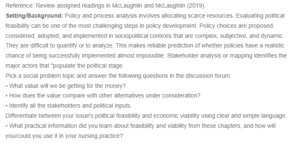Political Feasibility and Economic Viability
Value for the Money
One social problem topic in nursing that is currently gaining attention is the issue of nurse-to-patient ratios. The issue is that many healthcare facilities need more staffing levels, leading to nurses being overworked and stressed, which can negatively impact patient outcomes.
One potential solution to this problem is implementing legislation that sets minimum nurse-to-patient ratios in healthcare facilities. The value attained for the money spent on implementing this policy is improved patient outcomes. (Sparkes et al., 2019). Having enough nurses to provide adequate care for patients will decrease the risk of errors and adverse events, leading to better overall health outcomes for patients. Our assignment writing help is at affordable prices to students of all academic levels and academic disciplines.
Comparison of Value with Considered Alternatives
When comparing this alternative to other options, it is crucial to consider the financial cost of implementation and the potential benefits. Other alternatives include increasing pay for nurses to attract and retain more staff or investing in technology to automate some aspects of patient care (Sparkes et al., 2019). While these alternatives may also have benefits, they may need to address the root cause of the problem, which is inadequate staffing levels.
Stakeholders and Political Inputs
The stakeholders in this issue include nurses, patients, healthcare facilities, and government officials. Political inputs will come from legislators who must draft and pass legislation setting the minimum nurse-to-patient ratios and healthcare facility administrators who must implement the policy and allocate resources accordingly (Curtis & Craigo, 2019).
Political Feasibility vs. Economic Viability
Political feasibility refers to whether or not legislation setting minimum nurse-to-patient ratios will likely be passed and implemented. This will depend on factors such as public opinion, the positions of elected officials and political parties, and the current political climate (Sparkes et al., 2019).
Economic viability refers to whether healthcare facilities can financially sustain the cost of implementing such legislation and the necessary staffing increases (Sparkes et al., 2019). This considers factors such as the cost of hiring and training more nurses and the potential economic impact.
Lessons Learnt from Feasibility and Viability
From these chapters, we can learn that to address a social problem such as inadequate staffing levels effectively, it is crucial to consider both the political feasibility and economic viability of potential solutions. In nursing practice, nurses should be aware of the political and economic factors that may impact their ability to provide adequate patient care and advocate for solutions that address these issues (Curtis & Craigo, 2019). It also means that nurses should know the potential benefits and costs of different solutions and work with other stakeholders to identify the best approach for addressing the problem.
References
Curtis, P. M., & Craigo, D. M. (2019). Health policy analysis an interdisciplinary approach. Ch 8-13. McLaughlin and McLaughlin (2019) Ch 8 – 11
Sparkes, S. P., Bump, J. B., Özçelik, E. A., Kutzin, J., & Reich, M. R. (2019). Political economy analysis for health financing reform. Health Systems & Reform, 5(3), 183-194. https://doi.org/10.1080/23288604.2019.1633874
ORDER A PLAGIARISM-FREE PAPER HERE
We’ll write everything from scratch
Question

Political Feasibility and Economic Viability
Reference: Review assigned readings in McLaughlin and McLaughlin (2019).
Setting/Background: Policy and process analysis involves allocating scarce resources. Evaluating political feasibility can be one of the most challenging steps in policy development. Policy choices are proposed, considered, adopted, and implemented in sociopolitical contexts that are complex, subjective, and dynamic. They are difficult to quantify or to analyze. This makes reliable prediction of whether policies have a realistic chance of being successfully implemented almost impossible. Stakeholder analysis or mapping identifies the major actors that “populate the political stage.
Pick a social problem topic and answer the following questions in the discussion forum:
• What value will we be getting for the money?
• How does the value compare with other alternatives under consideration?
• Identify all the stakeholders and political inputs.
Differentiate between your issue’s political feasibility and economic viability using clear and simple language.
• What practical information did you learn about feasibility and viability from these chapters, and how will you/could you use it in your nursing practice?

